The Proline Market is estimated to be valued at USD 595.9 million in 2025 and is projected to reach USD 1122.8 million by 2035, registering a compound annual growth rate (CAGR) of 6.5% over the forecast period.
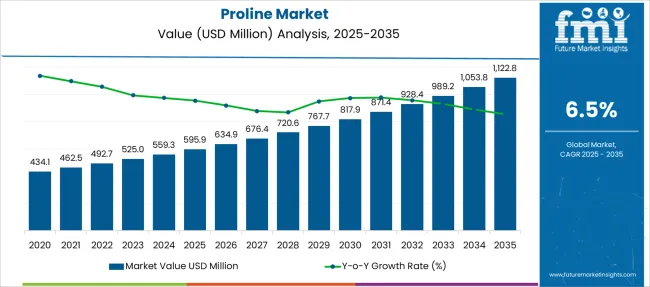
| Metric | Value |
|---|---|
| Proline Market Estimated Value in (2025 E) | USD 595.9 million |
| Proline Market Forecast Value in (2035 F) | USD 1122.8 million |
| Forecast CAGR (2025 to 2035) | 6.5% |
The proline market is growing steadily, supported by increasing demand for amino acids in food and health applications. Rising consumer interest in plant-based nutrition and natural ingredients has encouraged manufacturers to develop plant-derived proline products.
Proline’s role in supporting skin health, collagen synthesis, and overall metabolic functions has boosted its inclusion in dietary supplements and fortified foods. Additionally, food grade proline is favored for its safety and quality assurance in edible applications.
Expanding health and wellness trends, including a focus on protein supplementation and sports nutrition, have fueled growth in proline usage. Regulatory focus on product purity and labeling has also encouraged adherence to food grade standards. The market outlook remains positive with ongoing research exploring proline’s benefits in therapeutic and functional foods. Segmental growth is expected to be driven by plant-based products, food grade quality, and health and dietary supplements as key end-use sectors.
The market is segmented by Product Type, Grade, End Use, and Packaging and region. By Product Type, the market is divided into Plant-based and Animal-based. In terms of Grade, the market is classified into Food Grade and Pharmaceutical Grade. Based on End Use, the market is segmented into Health and Dietary Supplements, Animal Feed, Pharmaceuticals, and Biotechnology. By Packaging, the market is divided into Drums, Cartons, Boxes, and Others. Regionally, the market is classified into North America, Latin America, Western Europe, Eastern Europe, Balkan & Baltic Countries, Russia & Belarus, Central Asia, East Asia, South Asia & Pacific, and the Middle East & Africa.
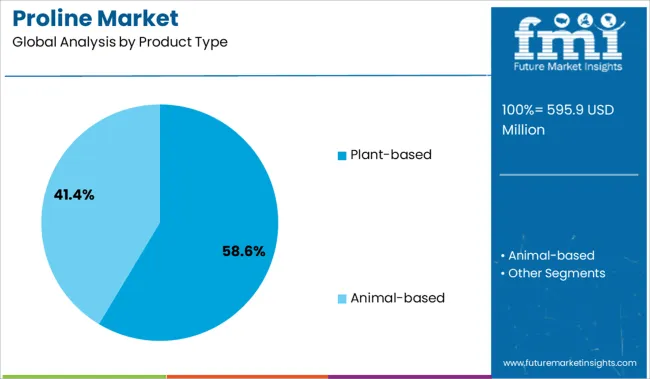
The plant-based segment is projected to hold 58.6% of the proline market revenue in 2025, establishing it as the dominant product type. This segment’s growth has been supported by the global shift toward plant-derived ingredients driven by consumer demand for sustainable and clean-label products.
Plant-based proline is valued for its natural origin, non-animal source, and compatibility with vegan and vegetarian dietary preferences. Manufacturers have increasingly adopted plant extraction and fermentation techniques to produce high-purity proline that meets consumer expectations.
The rising popularity of plant-based diets and functional foods has further stimulated demand for plant-derived amino acids. As sustainability concerns remain central to ingredient sourcing decisions, the plant-based proline segment is expected to maintain its strong market position.
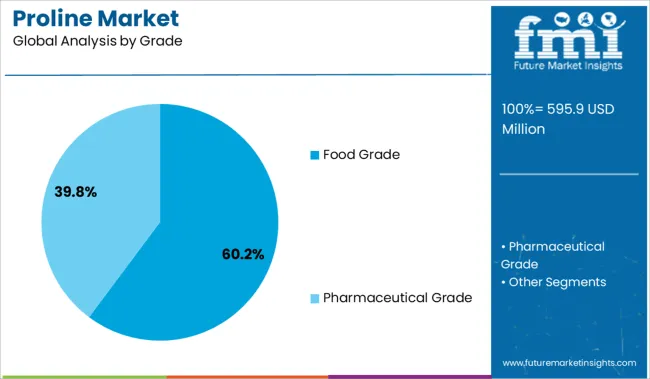
The food grade segment is projected to contribute 60.2% of the proline market revenue in 2025, maintaining its leadership among grade classifications. Growth in this segment is driven by the extensive use of proline in food and beverage formulations, including nutritional supplements, fortified foods, and protein-enhanced products.
The safety profile and regulatory compliance of food grade proline make it suitable for direct human consumption, which has encouraged widespread adoption. Food manufacturers and supplement producers prioritize food grade amino acids to ensure product quality and consumer trust.
Additionally, increasing focus on health and wellness products has propelled food grade proline as a preferred ingredient in formulations targeting skin health, muscle recovery, and metabolic support. With ongoing innovation in functional food applications, the food grade segment is expected to remain the market leader.
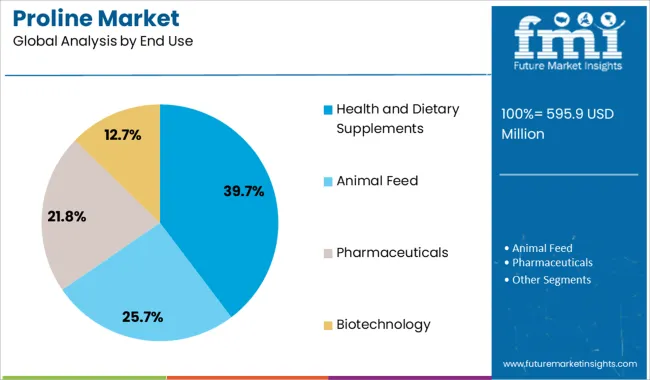
The health and dietary supplements segment is expected to account for 39.7% of the proline market revenue in 2025, holding the leading position in end-use sectors. Growth in this segment has been driven by the increasing consumer focus on personalized nutrition and supplementation to support overall wellness.
Proline’s role in collagen formation, joint health, and antioxidative properties has made it a popular choice in dietary supplements designed for skin care, sports nutrition, and aging-related health.
Rising awareness about amino acid benefits and the growing supplement market in both developed and emerging economies have fueled demand. Additionally, the expansion of online health product sales channels has improved accessibility and consumer reach. The health and dietary supplements segment is expected to maintain its dominance as consumers seek effective nutritional solutions.
The proline market has received a lot of traction in the industry.
Proline is most often found in pharmaceutical applications to provide solutions for heart diseases, exhibiting the fastest growth over the forecast period. The numerous applications of proline to support skin health have been the primary focus of research in the past few years, whereas the pharmaceutical segment is expected to experience the fastest growth of the proline market over the forecast period.
In response to growing health awareness among consumers, manufacturers of health and nutritional supplements have developed a series of health supplements, and this has led to increased demand for proline. This has been influenced by athletes who undergo prolonged workouts and experience decreases in proline levels, which is why proline supplements have increased in popularity in recent years.
The increasing production of amino acids in the region as well as the exports of feed additives from key countries, such as China and Japan, will contribute to the growth of the proline market on a regional basis.
The technological advancements such as modern production technologies, combined with large-scale production of proline, contribute to the reasonable price of the product, contributing positively to proline market growth. However, the fluctuating regulatory environment in different regions and price volatility of raw materials will decrease the growth rate of the proline market somewhat.
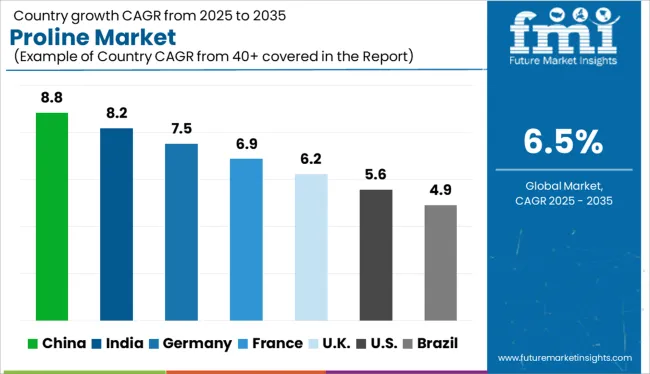
It is estimated that the regional market growth of the proline market will be driven by the growing production of amino acids in the region and growing exports of feed additives from key countries including China and Japan.
It is expected that growing demand for high-quality meat and meat products is expected to fuel the feed additives market in Europe, which, in turn, will fuel the amino acids consumption within the feed industry. Moreover, the use of animal feed additives that contain prominent amino acids such as lysine, methionine, and threonine for improving animal growth performance is expected to contribute to the growth in demand of proline in the regional market.
Proline-based health supplements have gained tremendous popularity in North America; due to this popularity, the market in North America is expected to grow substantially in the near future. In Asia Pacific, manufacturers are focusing on expansion as the region is emerging rapidly. Also, growth in research and development to launch efficient proline products is expected to offer lucrative opportunities for the growth of the proline market.
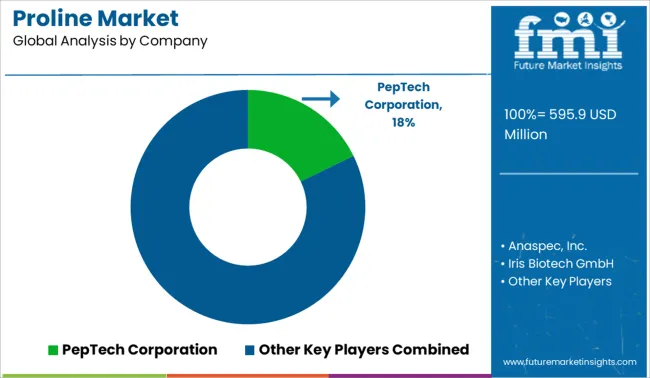
Some of the leading companies operating in the global proline market include PepTech Corporation, Anaspec, Inc., Iris Biotech GmbH, Ajinomoto Co. Inc.
As part of a recent agreement, Ajinomoto, a leading manufacturer of amino acids, authorized a Chinese company to produce amino acids for animal feed. Meihua Holdings Group will manufacture amino acids for the animal feed applications under the agreement.
Proline supplementation has increased in popularity in recent years due to increased health awareness among consumers; this has prompted manufacturers to introduce a variety of supplements; this has ultimately led to an increase in demand for proline. If athletes engage in prolonged workout sessions, the levels of proline decrease; this has led to an increase in proline supplementation.
Proline is becoming more affordable due to technological developments, along with large-scale production, which has contributed to the strong growth of the proline market. However, price instability of raw materials, in conjunction with fluctuating regulations, are expected to impede the market's growth rate a little.
| Report Attribute | Details |
|---|---|
| Growth Rate | CAGR of 6.54% from 2025 to 2035 |
| Base Year for Estimation | 2024 |
| Historical Data | 2020 to 2024 |
| Forecast Period | 2025 to 2035 |
| Quantitative Units | Revenue in USD Billion, Volume in Kilotons and CAGR from 2025 to 2035 |
| Report Coverage | Revenue Forecast, Volume Forecast, Company Ranking, Competitive Landscape, Growth Factors, Trends and Pricing Analysis |
| Segments Covered | Product Type, Grade, End User, Region |
| Regions Covered | North America; Latin America; Europe; East Asia; South Asia; Oceania ; Middle East and Africa |
| Key Countries Profiled | USA, Canada, Brazil, Mexico, Germany, UK, France, Spain, Italy, Russia, Poland, Australia, New Zealand, China, India, Japan, South Korea, Thailand, Malaysia, Vietnam, Indonesia, GCC, Turkey, South Africa, North Africa |
| Key Companies Profiled | PepTech Corporation; Anaspec, Inc.; Iris Biotech GmbH; Ajinomoto Co. Inc.; ChemPep Inc.; KYOWA HAKKO BIO CO., LTD.; Wuhan Vanz Pharm Inc.; Xi'an Huisun Bio to Tech Co., Ltd.; Star Lake; Wuxi Jinghai Amino Acid Co., Ltd; Hubei Bafeng Pharmaceutical and Chemical Share Co., Ltd.; Shijiazhuang Baokang Biotechnology Co., Ltd.; Xinjiang Meihua Amino Acid Co., Ltd.; Xi'an Natural Field Bio to Technique Co., Ltd.; Xi'an Lyphar Biotech Co., Ltd. |
| Customization | Available Upon Request |
The global proline market is estimated to be valued at USD 595.9 million in 2025.
The market size for the proline market is projected to reach USD 1,122.8 million by 2035.
The proline market is expected to grow at a 6.5% CAGR between 2025 and 2035.
The key product types in proline market are plant-based and animal-based.
In terms of grade, food grade segment to command 60.2% share in the proline market in 2025.






Full Research Suite comprises of:
Market outlook & trends analysis
Interviews & case studies
Strategic recommendations
Vendor profiles & capabilities analysis
5-year forecasts
8 regions and 60+ country-level data splits
Market segment data splits
12 months of continuous data updates
DELIVERED AS:
PDF EXCEL ONLINE
Hydroxyproline Market Analysis - Size, Share & Forecast 2025 to 2035

Thank you!
You will receive an email from our Business Development Manager. Please be sure to check your SPAM/JUNK folder too.
Chat With
MaRIA